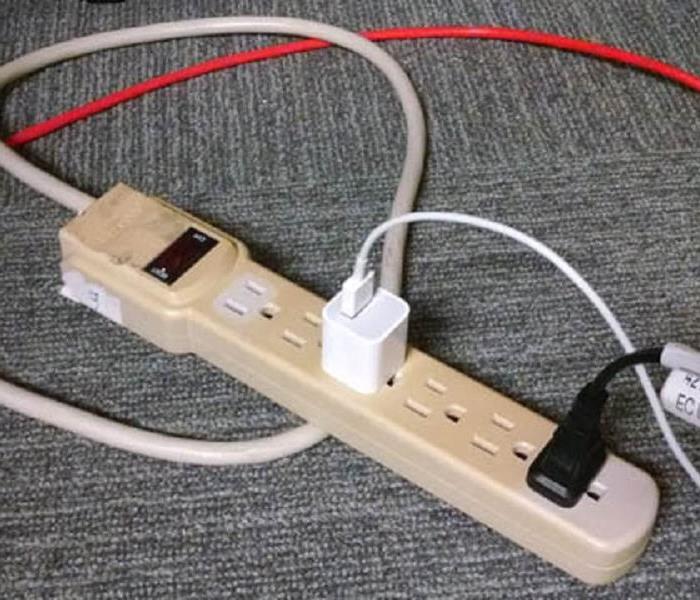Power Strips: Their Uses and Hazards
6/13/2016 (Permalink)
 Do not let this be a fire hazard!!!!!
Do not let this be a fire hazard!!!!!
A power strip is a length of electrical sockets attached to the end of a flexible cable that plugs into an electrical receptacle. It is used where electrical appliances in proximity demand more wall receptacles than are available. Inspectors may encounter these on the job while inspecting older homes that lack enough permanent electrical wall receptacles for the needs of today's families. Inspectors who understand the proper uses and limitations of power strips can advise their clients of a potential electrical hazards caused by their misuse. Power strips range in appearance from plastic-coated heads to banks of plug-in outlets encased in large metal boxes, often accompanied by LED switches that indicate when the units are turned on. Some models include a push button that automatically trips if the strip becomes too hot for safe operation. Inspectors can check for the following defective conditions:
“daisy-chaining,” where power strips or surge protectors have been plugged into other power strips and/or extension cords. The supply of available electrical outlets or receptacles in some older buildings may be insufficient, which encourages some homeowners to interconnect surge- protected power strips and/or extension cords. Such an arrangement violates National Electrical Code (NEC) and Occupational Safety and Health Administration (OSHA) regulations because the strip or wall receptacle may become overloaded, resulting in failure or fire;
the power strip is “permanently secured to building structures, tables, work benches or similar structures,” according to the Underwriters Laboratories (UL). Observe the photo at right where InterNACHI inspector David Nasser encountered an obviously dangerous condition;
routing of power strip cords through walls, ceilings, floors or similar openings;
overloading, which may be result in fire or electrocution, and may be caused by the following unsafe conditions:one wall receptacle serves multiple high-use power strips;the power strip serves an excessive number of appliances; andthe power strip serves high-voltage items that are not intended to be plugged into ancillary power sources, such as refrigerators, microwaves or space heaters.
wound or knotted cords. Power strip cords should be straight while in use;
no UL sticker describing the power strip as a “relocatable power tap.” Unlisted items have not been tested for safety and may contain defects such as insufficient protective coating over the wires;
the plug is hanging out of the receptacle. Plugs should be inserted fully into the receptacle so that no part of the metal prongs are exposed;
melted, burned, frayed, discolored or otherwise damaged wires. Discard any cord with exposed wires, cracks or splices;
the device is hot to the touch. If the power strip feels hot, unplug it immediately;
it is located in an area where air circulation is limited, which may lead to overheating, such as beneath carpeting or behind furniture;
it is located in a moist environment (see photo at right);
it is used as permanent wiring, which is defined as wiring used for a period greater than 90 days, according to the U.S. Office of Compliance;
its grounding wire has been cut off to fit into an ungrounded electrical receptacle;
its cord length is excessive, as this may present a trip hazard. According to the UL, “The length of the power-supply cord, as measured from the outside surface of the enclosure of the relocatable power tap to the plane of the face of the attachment plug, should not exceed 25 feet (7.62 m) nor be less than 1.5 feet (0.46 m).” Other sources, however, warn against power strip cords of shorter lengths; and
it is in use at a construction site, such as a building site for a new home, to power high-voltage equipment;
it is in use at a healthcare facility to power medical equipment. The UL states that power strips “have not been investigated and are not intended for use with general patient-care areas or critical patient-care areas of healthcare facilities.”Note that while power strips are designed to distribute electricity, they do not regulate power flow or block electrical spikes or surges. Surge protection is incorporated into some power strips, but it should never be assumed that a power strip offers surge protection without inspecting the unit for the proper UL designation. The misconception that power strips are also surge protectors can lead to costly damage to electrical equipment during a power surge.
In summary, power strips are lengths of electrical sockets that allow multiple appliances to be powered; however, as with all types of extension cords, they should be used sparingly and temporarily with small appliances and electronics, rather than as a substitute for a permanent wall receptacle. Inspectors who observe their improper use may wish to warn their clients of a potential shock or fire hazard.





 24/7 Emergency Service
24/7 Emergency Service